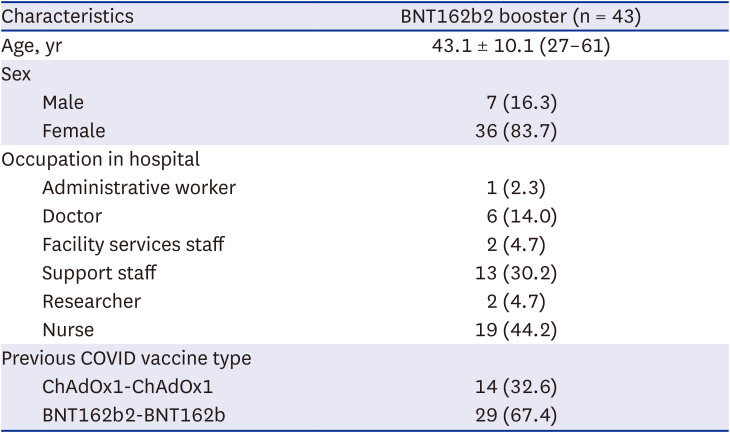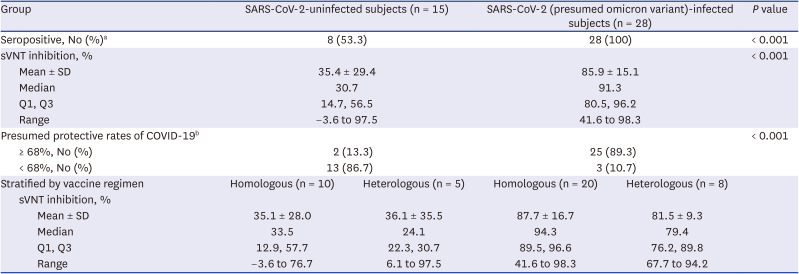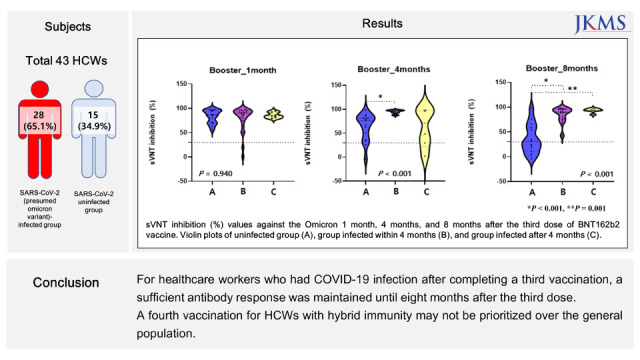2. Bar-On YM, Goldberg Y, Mandel M, Bodenheimer O, Amir O, Freedman L, et al. Protection by a fourth dose of BNT162b2 against Omicron in Israel. N Engl J Med. 2022; 386(18):1712–1720. PMID:
35381126.

3. Nham E, Song JY, Noh JY, Cheong HJ, Kim WJ. COVID-19 vaccination in Korea: past, present, and the way forward. J Korean Med Sci. 2022; 37(47):e351. PMID:
36472087.

4. Magen O, Waxman JG, Makov-Assif M, Vered R, Dicker D, Hernán MA, et al. Fourth dose of BNT162b2 mRNA Covid-19 vaccine in a nationwide setting. N Engl J Med. 2022; 386(17):1603–1614. PMID:
35417631.

5. Nordstrom P, Ballin M, Nordstrom A. Effectiveness of a fourth dose of mRNA COVID-19 vaccine against all-cause mortality in long-term care facility residents and in the oldest old: a nationwide, retrospective cohort study in Sweden. Lancet Reg Health Eur. 2022; 21:100466. PMID:
35855494.
6. Cohen MJ, Oster Y, Moses AE, Spitzer A, Benenson S. Israeli-Hospitals 4th Vaccine Working Group. Association of receiving a fourth dose of the BNT162b vaccine with SARS-CoV-2 infection among health care workers in Israel. JAMA Netw Open. 2022; 5(8):e2224657. PMID:
35917125.

7. Lim SH, Choi SH, Kim B, Kim JY, Ji YS, Kim SH, et al. Serum antibody response comparison and adverse reaction analysis in healthcare workers vaccinated with the BNT162b2 or ChAdOx1 COVID-19 vaccine. Vaccines (Basel). 2021; 9(12):1379. PMID:
34960125.

9. Planas D, Saunders N, Maes P, Guivel-Benhassine F, Planchais C, Buchrieser J, et al. Considerable escape of SARS-CoV-2 Omicron to antibody neutralization. Nature. 2022; 602(7898):671–675. PMID:
35016199.

10. Abu-Raddad LJ, Chemaitelly H, Ayoub HH, AlMukdad S, Yassine HM, Al-Khatib HA, et al. Effect of mRNA Vaccine Boosters against SARS-CoV-2 Omicron Infection in Qatar. N Engl J Med. 2022; 386(19):1804–1816. PMID:
35263534.

11. Buchan SA, Chung H, Brown KA, Austin PC, Fell DB, Gubbay JB, et al. Estimated effectiveness of COVID-19 vaccines against Omicron or Delta symptomatic infection and severe outcomes. JAMA Netw Open. 2022; 5(9):e2232760. PMID:
36136332.

12. Thompson MG, Natarajan K, Irving SA, Rowley EA, Griggs EP, Gaglani M, et al. Effectiveness of a third dose of mRNA vaccines against COVID-19-associated emergency department and urgent care encounters and hospitalizations among adults during periods of Delta and Omicron variant predominance - VISION Network, 10 States, August 2021-January 2022. MMWR Morb Mortal Wkly Rep. 2022; 71(4):139–145. PMID:
35085224.

13. Regev-Yochay G, Gonen T, Gilboa M, Mandelboim M, Indenbaum V, Amit S, et al. Efficacy of a fourth dose of Covid-19 mRNA vaccine against Omicron. N Engl J Med. 2022; 386(14):1377–1380. PMID:
35297591.

14. Cirillo N. Do health-care workers need a COVID-19 vaccine booster? Lancet Infect Dis. 2022; 22(1):20.

15. Lim S, Sohn M. How to cope with emerging viral diseases: Lessons from South Korea's strategy for COVID-19, and collateral damage to cardiometabolic health. Lancet Reg Health West Pac. 2023; 30:100581. PMID:
36093123.

17. Kwon SR, Kim N, Park H, Minn D, Park S, Roh EY, et al. Strong SARS-CoV-2 antibody response after booster dose of BNT162b2 mRNA vaccines in uninfected healthcare workers. J Korean Med Sci. 2022; 37(19):e135. PMID:
35578582.

19. Lim SH, Kim HJ, Kim SH, Choi SH, Kim B, Kim JY, et al. Effects of Omicron infection and changes in serum antibody response to wild-type, Delta, and Omicron after a booster dose with BNT163b2 vaccine in Korean healthcare workers. J Korean Med Sci. 2023; 38(13):e103. PMID:
37012688.

20. Flacco ME, Acuti Martellucci C, Baccolini V, De Vito C, Renzi E, Villari P, et al. Risk of reinfection and disease after SARS-CoV-2 primary infection: Meta-analysis. Eur J Clin Invest. 2022; 52(10):e13845. PMID:
35904405.

21. Suryawanshi R, Ott M. SARS-CoV-2 hybrid immunity: silver bullet or silver lining? Nat Rev Immunol. 2022; 22(10):591–592. PMID:
35945353.

22. Goldberg Y, Mandel M, Bar-On YM, Bodenheimer O, Freedman LS, Ash N, et al. Protection and waning of natural and hybrid immunity to SARS-CoV-2. N Engl J Med. 2022; 386(23):2201–2212. PMID:
35613036.

23. Zar HJ, MacGinty R, Workman L, Botha M, Johnson M, Hunt A, et al. Natural and hybrid immunity following four COVID-19 waves: a prospective cohort study of mothers in South Africa. EClinicalMedicine. 2022; 53:101655. PMID:
36128333.

24. Altarawneh HN, Chemaitelly H, Hasan MR, Ayoub HH, Qassim S, AlMukdad S, et al. Protection against the Omicron variant from previous SARS-CoV-2 infection. N Engl J Med. 2022; 386(13):1288–1290. PMID:
35139269.

25. Heo K, Jeong K, Lee D, Seo Y. A critical juncture in universal healthcare: insights from South Korea’s COVID-19 experience for the United Kingdom to consider. Humanit Soc Sci Commun. 2021; 8(1):57.









 PDF
PDF Citation
Citation Print
Print




 XML Download
XML Download